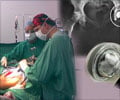Recent studies of inflammation in spinal arthritis implicate the enthesis, which is the attachment site of ligament or tendon to bone as being a potential driving factor in joint inflammation.
The most common degenerative joint disease, osteoarthritis (OA) is marked by the breakdown of articular cartilage, which is the type of cartilage that lines the ends of most limb bones. It can afflict any joint—fingers, toes, wrists, ankles, elbows, shoulders, and the spine, as well as the weight-bearing knees and hips. As OA progresses, sufferers often experience inflammation around the affected joint. This inflammation has been attributed to bits of cartilage breaking off and aggravating the synovium, the thin, smooth membrane lining a joint. Yet, MRI detection of prominent synovitis in early OA—when joint cartilage appears normal—suggests that other joint structures may be involved in triggering this inflammation. Recent studies of inflammation in spinal arthritis implicate the enthesis, which is the attachment site of ligament or tendon to bone as being a potential driving factor in joint inflammation.
Intrigued by the potential role of tendon or ligament attachment sites in synovitis, Professors Michael Benjamin of Cardiff University and Dennis McGonagle of the University of Leeds decided to investigate the extent to which different entheses could contribute to inflammation by forming a functional unit and destructive partnership with adjacent synovium. Featured in the November 2007 issue of Arthritis & Rheumatism, their findings shed light on a potential novel mechanism for synovial inflammation in degenerative arthritis. This is based on a structure that the authors have called the “synovial-entheseal complex” (SEC). Basically insertions have a different type of cartilage called fibrocartilage near the bone. Although this is different from articular cartilage that lines the ends of bones, the authors speculated that this type of cartilage could also derive nourishment from synovium. However, this close integration although desirable in health could have unfortunate consequences if the enthesis was damaged.To validate the widespread formation and to explore further, the possible inflammatory function of SECs, researchers collected ligament and tendon attachment samples from 60 cadavers, 35 male and 25 female, with a mean age of 84 years at death. 49 different entheses—19 from the arms, 26 from the legs, and 4 from the spinal column—were preserved for examination. To exclude cartilage degeneration as a trigger for synovial inflammation, 17 of the selected entheses were not immediately adjacent to joint cartilage. Each sample was studied for evidence of inflammatory cells and soft tissue microdamage, as well as for the composition of SECs.
At 82 percent of the entheses, the formation of a SEC was found. As expected, this occurred in entheses very close to joint cartilage, where the synovium was often part of the joint itself. However, a SEC was also detected in 47 percent of the sites separated from joint cartilage. For example, the SEC found at the Achilles tendon was formed with synovium that protruded from a cavity called a “bursa”, located a considerable distance from the ankle joint.
Joint insertions are sites of high mechanical stressing and the authors speculated that this could lead to damage within them, including their fibrocartilage This is exactly what the authors found. Degenerative changes—at least one and sometimes several—were detected on the soft tissue side of attachment sites. Most notably, cell clustering and/or fissuring was found in 76 percent of entheses. In 85 percent of SECs, the synovial component also showed evidence of mild inflammatory change. Finally, in 73 percent of the attachments, small numbers of inflammatory cells were present in the enthesis itself. Therefore the authors suggest that joint degeneration of fibrocartilage at insertions could trigger inflammation within SECs.
As Professors Benjamin and McGonagle note, one their most striking findings was the large number of attachment sites with evidence of changes in the entheses mirroring those typically seen in joint cartilage in OA—fibrocartilage cell clusters, cell hypertrophy, and fissuring among them. “Such changes at certain entheses could be directly relevant to older subjects with joint symptoms due to degenerative disease,” Professor McGonagle observes, “and some of the symptoms could be emanating from the SEC.”
Affirming the concept of a “synovio-etheseal complex” as widely applicable at many sites in the body, both right next to and removed from joint cartilage, this study also supports the idea that biomechanical factors related to the enthesis could play an important role in synovial inflammation in both degenerative and inflammatory arthritis.
GAN/V











